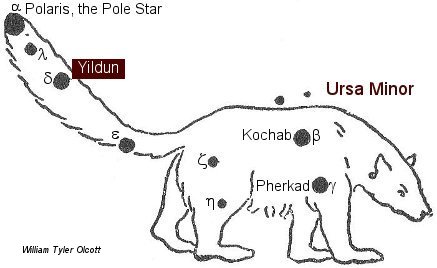| Fixed star: YILDUN Pherkard | |
| Constellation: Delta (δ) Ursa Minor | |
| Longitude 1900: 29GEM48 | Longitude 2000: 01CAN12 |
| Declination 1900: +86.37′ | Declination 2000: +86.35′ |
| Right ascension: 17h 32m | Latitude: +69.56′ |
| Spectral class: A0 | Magnitude: 4.4 |
The history of the star: Yildun
from p.460 of Star Names, Richard Hinckley Allen, 1889.

Yildun is generally given to this, probably from the Turkish Yilduz that is better applied to alpha (α Polaris); but it has degenerated to Vildiur, and the Century Dictionary has Gildun, perhaps by a typographical error.
The 17th century German astronomer Bayer’s (Greek) choreutes prote for gamma (γ Pherkad), and choreutes deutera for the adjoining epsilon (ε), the First and the Second Dancer, were also general designations in which alpha (α Polaris), beta (β Kochab), and the two stars gamma (γ Pherkad) were included.
Star Names, Their Lore and Meaning, Richard Hinckley Allen, 1889].
This “dancing” of the stars generally, as well as of the planets, was a favorite simile, and in classical days specially gave name to delta (Yildun) and epsilon of this constellation, as well as in Hindu astronomy. The Greeks had for delta, “First Dancer” and for the adjoining epsilon, the “Second Dancer”, there were also general designations in which alpha, beta, and the two stars gamma were included.
Alpha (Polaris), beta (Kochab), gamma (Pherkad) delta (Yildun), and epsilon constituted the group Circitores, Saltatores, Ludentes, or Ludiones, the “Circlers”, “Leapers”, or “Dancers” around the early pole, well known from classical times to late astronomy.
The astrological influences of the constellation Ursa Minor
Legend: According to some accounts this constellation, Ursa Minor, represents Arcas, son of Callisto and Jupiter (see Bootes and Ursa Major). Other writers state that it is meant to represent Cynosura, one of the Nymphs of Crete who reared the infant Jupiter; the other, Helice, being Ursa Major. [Robson, p.65-66.]
Influences: According to Ptolemy the bright stars are like Saturn and in some degree like Venus. It is said to give indifference and improvidence of spirit, and to lead to many troubles. By the Kabalists it is associated with the Hebrew letter Tau and the 21st Tarot Trump “The Universe.” [Robson, p.66.]
The astrological influences of the constellation Ursa Minor given by Manilius:
“Now where heaven reaches its culmination in the shining Bears (Ursa Major and Ursa Minor), which from the summit of the sky look down on all the stars and know no setting and, shifting their opposed stations about the same high point, set sky and stars in rotation, from there an insubstantial axis runs down through the wintry air and controls the universe, keeping it pivoted at opposite poles: it forms the middle about which the starry sphere revolves and wheels its heavenly flight, but is itself without motion and, drawn straight through the empty spaces of the great sky to the two Bears and through the very globe of the Earth, stands fixed, since the entire atmosphere ever revolves in a circle, and every part of the whole rotates to the place from which it once began, that which is in the middle, about which all moves, so insubstantial that it cannot turn round upon itself or even submit to motion or spin in circular fashion, this men have called the axis, since, motionless itself, it yet sees everything spinning about it.
“The top of the axis is occupied by constellations well known to hapless mariners, guiding them over the measureless deep in their search for gain. Helice (Ursa Major), the greater, describes the greater arc; it is marked by seven stars which vie with each other under its guidance the ships of Greece set sail to cross the seas.
Cynosura (Ursa Minor) is small and wheels round in a narrow circle, less in brightness as it is in size, but in the judgment of the Tyrians it excels the larger bear.
“Carthaginians count it the surer-guide when at sea they make for unseen shores. They are not set face to face: each with its muzzle points at the other’s tail and follows one that follows it. Sprawling between them and embracing each the Dragon (Draco) separates and surrounds them with its glowing stars lest they ever meet or leave their stations.” [Astronomica, Manilius, 1st century AD, p.27].
References:
Fixed Stars and Constellations in Astrology, Vivian E. Robson, 1923].